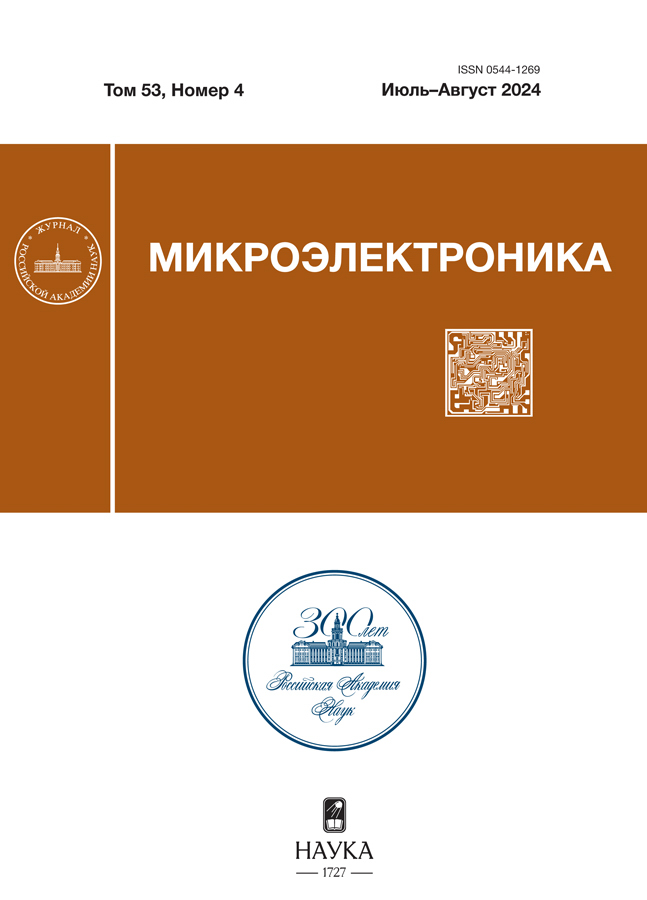Plasmochemical and Reactive Ion Etching of Gallium Arsenide in Difluorodichloromethane with Helium
- Authors: Murin D.B.1, Chesnokov I.A.1, Gogulev I.A.1, Anokhin A.L.1, Moloskin A.E.1
-
Affiliations:
- Ivanovo State Chemical-Technological University
- Issue: Vol 53, No 4 (2024)
- Pages: 346-352
- Section: TECHNOLOGIES
- URL: https://kld-journal.fedlab.ru/0544-1269/article/view/655219
- DOI: https://doi.org/10.31857/S0544126924040078
- ID: 655219
Cite item
Abstract
The kinetics of interaction of high-frequency plasma of difluorodichloromethane and its mixture with helium with the surface of gallium arsenide was experimentally studied. It was established that in the studied range of conditions, complete decomposition of the original difluorodichloromethane molecule to atomic carbon occurs. It has been confirmed that the main chemically active particles responsible for etching are reactive chlorine atoms. It has been shown that the etching process occurs in the mode of an ion-stimulated chemical reaction, where the desorption of products under the influence of ion bombardment plays a significant role in surface cleaning. The emission spectra of plasma radiation in the presence of a gallium arsenide semiconductor wafer are analyzed. Control lines and stripes were selected to control the speed of the etching process based on the emission intensity of the lines and stripes of the etching products.
Full Text
About the authors
D. B. Murin
Ivanovo State Chemical-Technological University
Author for correspondence.
Email: dim86@mail.ru
Russian Federation, Ivanovo
I. A. Chesnokov
Ivanovo State Chemical-Technological University
Email: dim86@mail.ru
Russian Federation, Ivanovo
I. A. Gogulev
Ivanovo State Chemical-Technological University
Email: dim86@mail.ru
Russian Federation, Ivanovo
A. L. Anokhin
Ivanovo State Chemical-Technological University
Email: dim86@mail.ru
Russian Federation, Ivanovo
A. E. Moloskin
Ivanovo State Chemical-Technological University
Email: dim86@mail.ru
Russian Federation, Ivanovo
References
- Danilin B.S., Kireev V.Yu. Application of low-temperature plasma for etching and cleaning of materials. Moscow: Energoatomizdat, 1987. P. 264.
- Dunaev A.V., Sitanov D.V., Murin D.B. General features of interaction between copper and chlorine-containing gases // High Energy Chemistry. 2017. V. 51. No. 3. P. 239–243. https://doi.org/DOI: 10.1134/S0018143917030031
- Franz G., Kelp A., Messerer P. Analysis of chlorine-containing plasmas applied in III/V semiconductor processing // J. Vac. Sci. Technol. 2000. V. 18. No. 5. P. 2053–2061. https://doi.org/10.1116/1.1286072
- Ibbotson D.E. Plasma and gaseous etching of compounds of Groups III–V // Pure and Appl. Chem. 1988. V. 60. No. 5. P. 703–708. https://doi.org/10.1351/pac198860050703
- Efremov A.M., Svetsov V.I., Pivovarenok S.A., Dunaev A.V. Kinetics of GaAs etching in chlorine plasma // Izv. VUZov. Chemistry and chem. technology. 2010. V. 53. No. 5. P. 53–56.
- Grigonis A. The surface composition of GaAs affected by reactive plasma // Surf. Coat. Technol. Vol. 1998. V. 110. No. 1–2. P. 31–34. https://doi.org/10.1016/S0257-8972(98)00551-9
- Efremov A.M., Murin D.B., Leventsov A.E. Kinetics and modes of plasmachemical etching of GaAs under conditions of induction HF discharge in CF2Cl2 // Microelectronics. 2014. V. 43. No. 6. P. 429–434. https://doi.org/DOI: 10.1134/S1063739714060031
- Pearse R.W.B., Gaydon A.G. The identification of molecular spectrum. Fourth edition. New York: John Wiley & Sons, inc. 1976. P. 407. ISBN: 978-94-009-5760-2
- Striganov A.R., Sventitsky N.S. Tables of spectral lines of neutral and ionized atoms. Moscow: Atomizdat. 1966. P. 899. https://doi.org/10.1007/978-1-4757-6610-3
- Wang Y.F., Lee W.J., Chen C.Y. Reaction Mechanisms in Both a CCl2F2/O2/Ar and a CCl2F2/H2/Ar RF Plasma Environment // Plasma Chem. and Plasma Proceedings. V. 20. No. 4. 2000. P. 469–494 https://doi.org/DOI 10.1023/A:1007027805680
- Stoffels W.W., Stoffels E., Haverlag M. The chemistry of a CCl2F2 radio frequency discharge // J. Vac. Sci. Technol. A.V. 13. No. 4. 1995. P. 2058–2066. https://doi.org/10.1116/1.579652
- Glauco F. Bauerfeldt and Graciela Arbilla. Kinetic analysis of the chemical processes in the decomposition of gaseous dielectrics by a non-equilibrium plasma — Part 1: CF4 and CF4/O2 // J. Braz. Chem. Soc. 2000. V. 11. No. 2. P. 121. https://doi.org/10.1590/S0103-50532000000200004
- Efremov A.M., Kim D.P., Kim C.I. Effect of gas mixing ratio on gas-phase composition and etch rate in an inductively coupled CF4/Ar plasma // Vacuum. 2004. V. 75. No. 2. P. 133–142. https://doi.org/10.1016/j.vacuum.2004.01.077
- Zhang D., Kushner M.J. Mechanisms for CF2 radical generation and loss on surfaces in fluorocarbon plasmas // Journal of Vacuum Science & Technology A.: Vacuum, Surfaces, and Films. 2000. V. 18. No. 6. P. 2661–2668. https://doi.org/10.1116/1.1319816
- Pivovarenok S.A., Dunaev A.V., Murin D.B. Kinetics of the interaction between a CCl2F2 radio-frequency discharge and gallium arsenide // Microelectronics. 2016. V. 45. No. 5. P. 374–378. https://doi.org/10.1134/S1063739716040089
Supplementary files
















